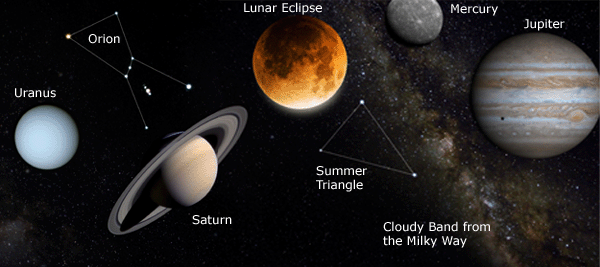 The
Night Sky: What to Look for in 2011
The
Night Sky: What to Look for in 2011Every year the Creator provides us with a feast of heavenly wonders at night. Be sure to enjoy some of them in the coming year.
Unless otherwise indicated, the events described are for the early evening hours, and the location of celestial objects described here is for the United States, Europe, and other mid-northern latitudes. However, most of the events and objects described here can be seen in either hemisphere, though the apparent position in the sky for other latitudes will be somewhat different from the description.
January & February (around 9:00 p.m.)
One of the most recognizable constellations, Orion, is high in the south. The three blue belt stars shine prominently. A small star cluster, the Pleiades, is very high in the southwest. This cluster is visible to the unaided eye and looks magnificent through binoculars.
Jupiter shines brightly, low in the west. On January 4, Jupiter passes just below the planet Uranus. Uranus will be easily visible in binoculars as the faint blue “star” just above Jupiter by about ½ degree (the width of the moon). On January 4, Europe is treated to a spectacular partial solar eclipse.
March & April (around 9:30 p.m.)
Sirius, the brightest star in the nighttime sky, shines low in the south, to the left of Orion. High in the east lies the faint but beautiful Coma Berenices star cluster. Two bright red stars dominate the western sky: Betelgeuse (just above Orion’s Belt) and Aldebaran to the right. Saturn is now visible in the evening sky, low in the east. Around midnight, Saturn is high and very well-placed for viewing.
May & June (around 10:00 p.m.)
Saturn is now high in the south and easy to view. The Big Dipper is very high in the northern sky. Just before sunrise on May 11, there will be a beautiful conjunction (a close grouping) of Jupiter, Venus, and Mercury low in the east. These three planets will form a straight line with Jupiter and Venus pointing directly toward the fainter Mercury. This is a rare opportunity for those who have never seen Mercury, which is normally somewhat difficult to find.
On June 15, a lunar eclipse will occur. It will not be visible in the Americas but can be seen in the evening sky for Africa and the Middle East, and in the morning sky for India, Southern China, and Australia.
July & August (around 10:00 p.m.)
Saturn is still visible low in the southwest. Our own galaxy, the Milky Way, is easily visible as a cloudy band high in the eastern sky. The “Summer Triangle” is now visible very high in the east. It is composed of Vega, Deneb, and Altair—the three brightest stars in the eastern sky. The bright red supergiant Antares—which is 700 times the diameter of our sun—is low in the south. The orange giant star Arcturus is very high in the west. The annual Perseid meteor shower (August 12–13) will be largely washed-out by bright light from the nearly full moon.
September & October (around 9:30 p.m.)
This is the best time of the year for early-evening telescope viewing. The Milky Way stretches high overhead, and even a small telescope reveals dozens of star clusters and nebulae within. The summer triangle is directly overhead. Jupiter becomes visible late in the evening, low in the eastern sky.
November & December (around 9:00 p.m.)
Jupiter dominates the southern sky, whereas Venus is now visible very low in the southwest just after sunset. Around November 16, Mercury will be well-placed for viewing just after sunset, and very close to Venus. The Andromeda Galaxy (M31) is visible almost directly overhead. It appears as a faint elongated cloud to the unaided eye under dark skies.

Images (from left to right): JPL; NASA/JPL/Space Science Institute; NASA; NASA/Johns Hopkins University Applied Physics Laboratory/Carnegie Institution of Washington; JPL